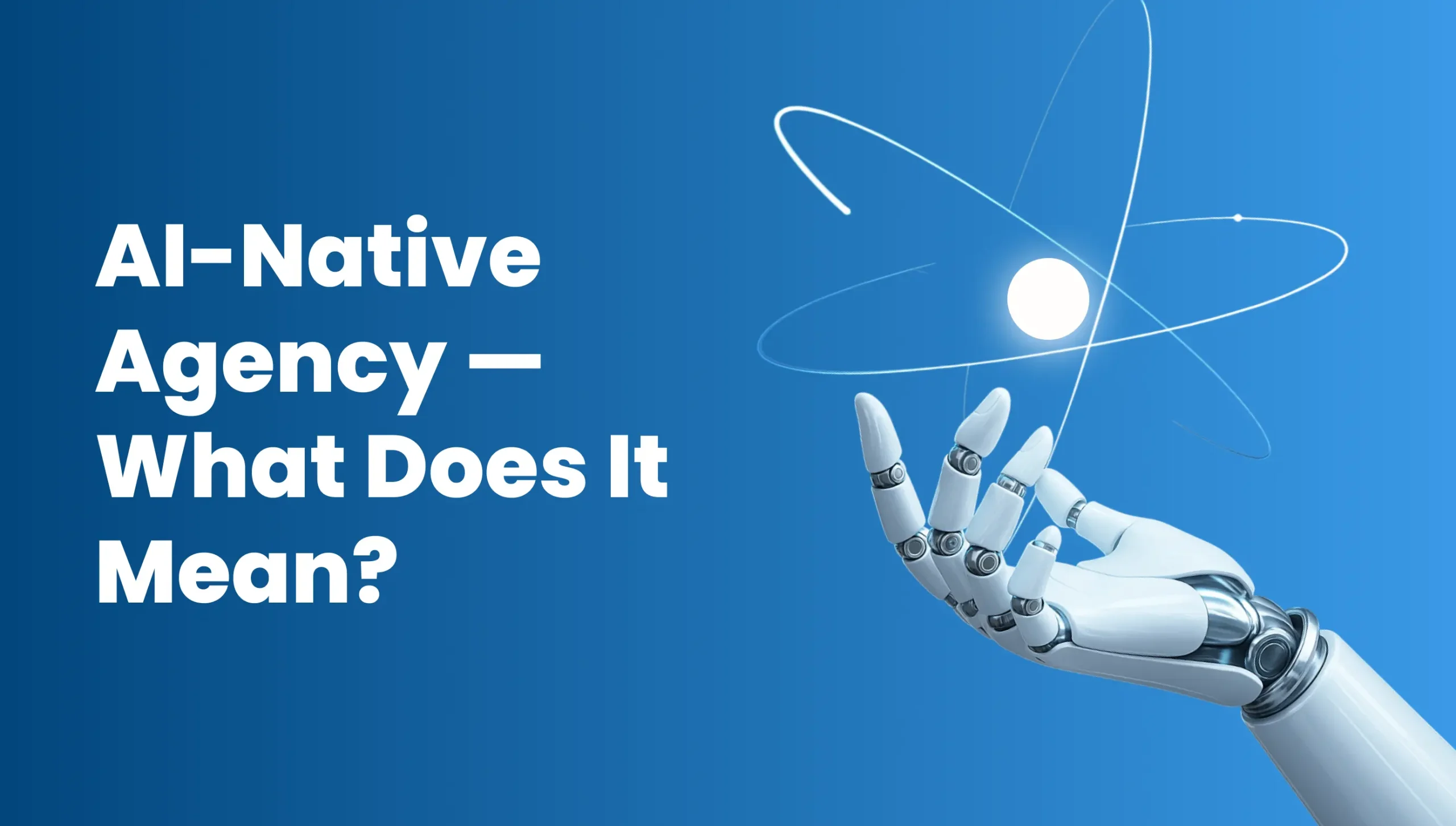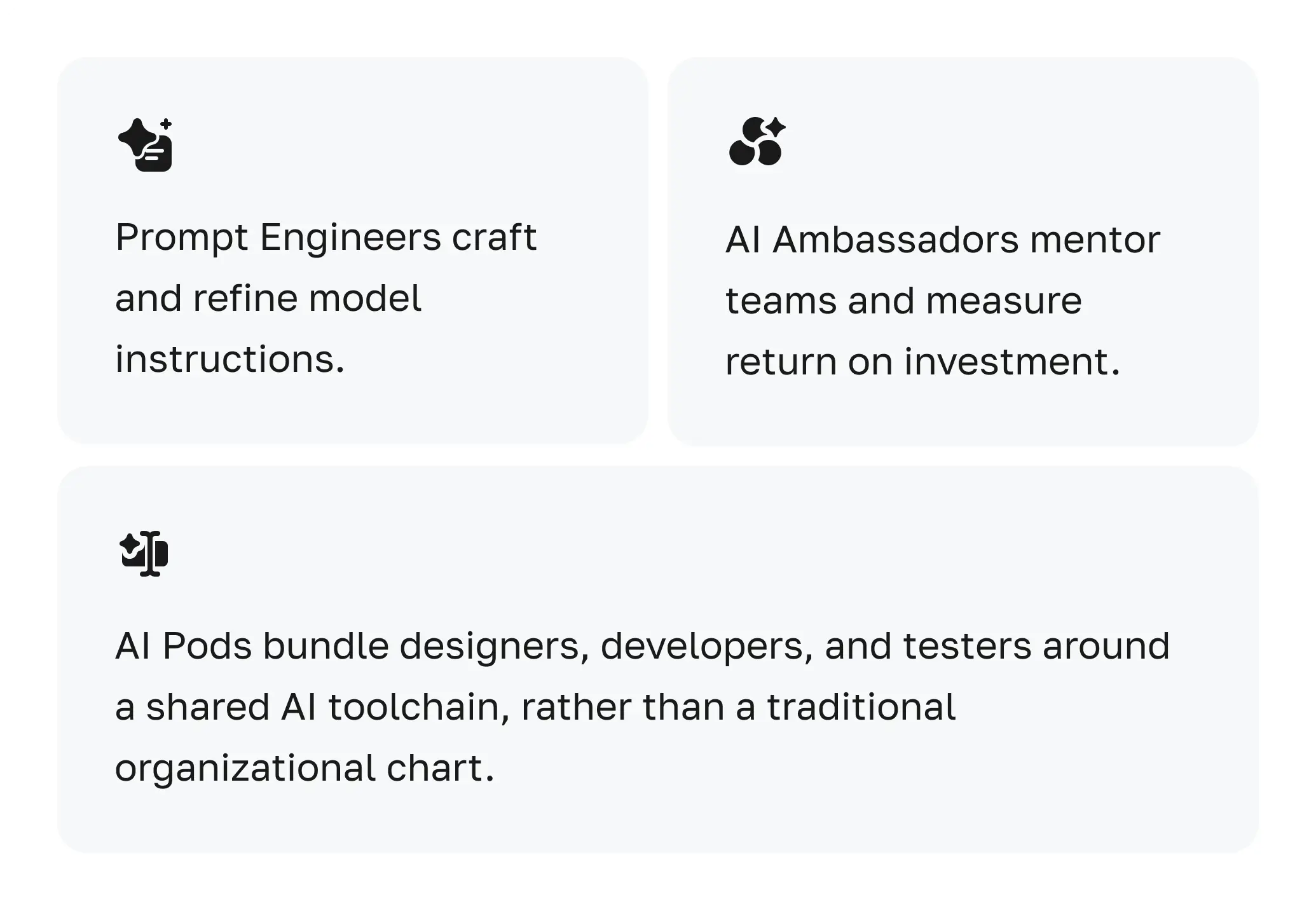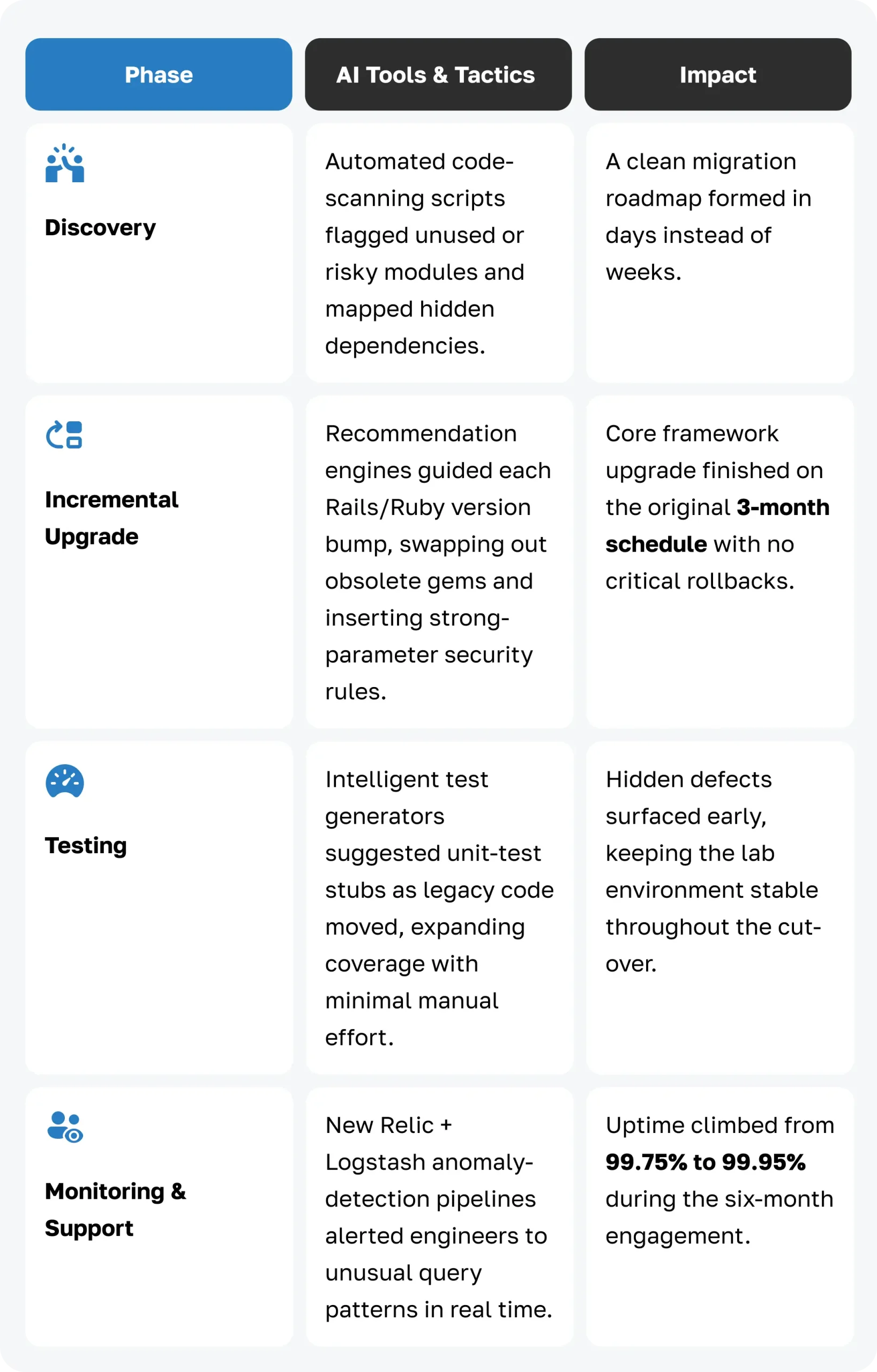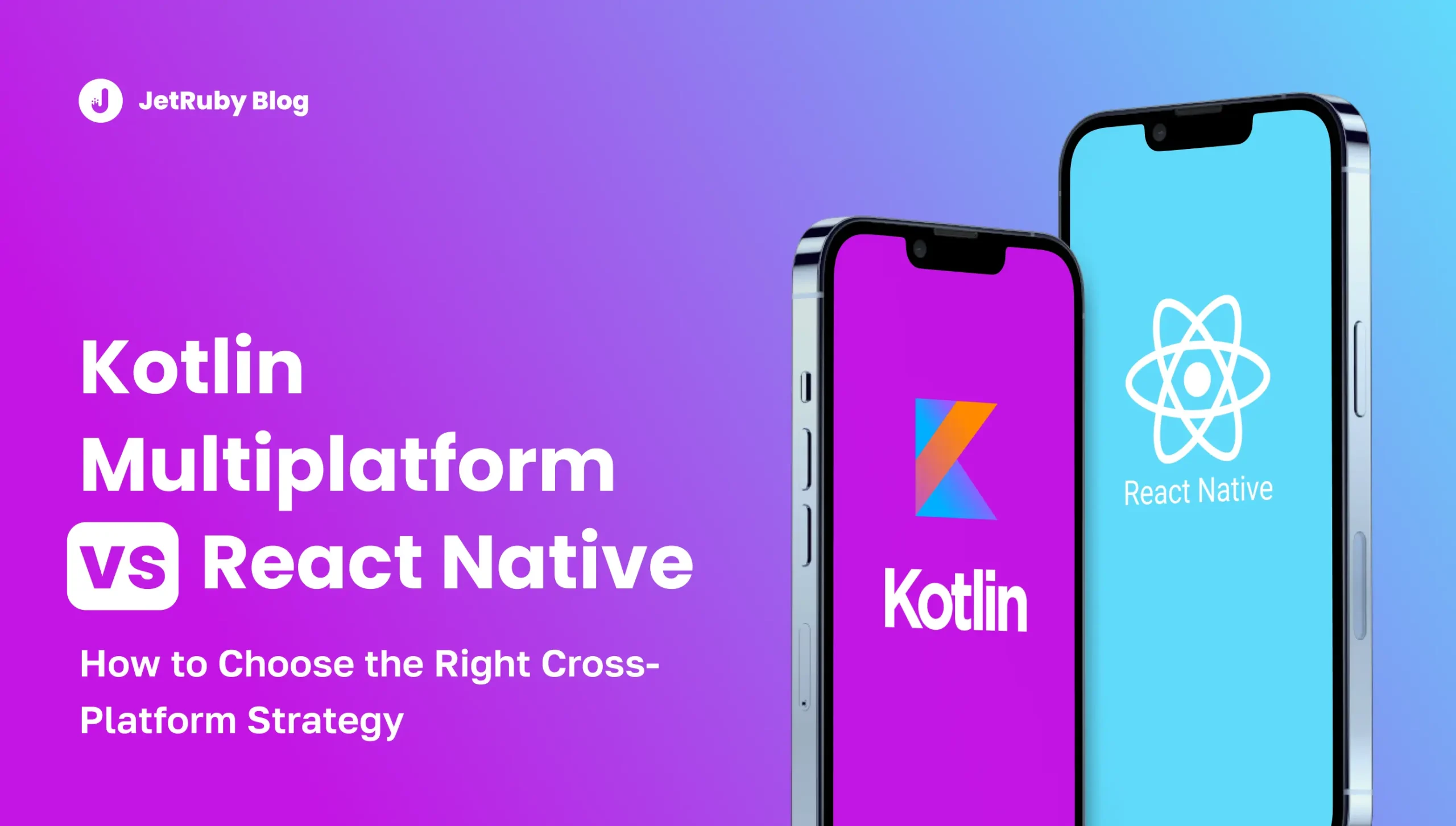Table of Contents
78% of organizations already apply AI to at least one core function, up from just 55% the year before.
McKinsey estimates the extra economic value of generative AI to be $2.6-$4.4 trillion annually, roughly equivalent to Germany’s GDP.
With the global Gen-AI market on track to break $34 billion in 2025, waiting for “maturity” is no longer an option.
That surge is rewriting the playbook you follow to build, market, and support digital products. Teams that bolt AI onto yesterday’s workflows still battle long release cycles and ballooning costs. Teams that design processes around AI from day one sidestep those bottlenecks and pull ahead.
JetRuby has lived in both realities.
We started with isolated pilots, code copilots in dev, smart routing in support, predictive spend in marketing. Lessons from those early wins fueled a company-wide shift: every sprint, every stand-up, and every customer touchpoint now runs with AI assistance.
The payoff shows up in shorter feedback loops, leaner budgets, and quicker pivots when your market moves.
What Is an AI-Native Agency?
An AI-native agency builds every workflow with artificial intelligence at the center. AI isn’t a plug-in, It’s the default toolkit your project uses from the first user interview to post-launch support.
Your SaaS team already knows the power of being cloud-native; software that lives in the cloud from day one scales faster than apps that migrate later.
The same rule now applies to AI. When your partner is AI-native, you inherit a culture, process, and tech stack that assumes models, copilots, and data pipelines are always on.
How an AI-Native Agency Works
- Research – Language models scrape market chatter and spot gaps your competitors miss.
- Planning – Generative tools draft specs, risk maps, and story points in hours, not weeks.
- Development – Code copilots cut boilerplate; AI-driven test suites flag edge cases early. The post AI Test Automation: AI Tools for Unit Tests breaks down the essentials.
- Support – Smart agents solve tier-one tickets 24/7 while your experts focus on high-value work.
Why the Term Appeared Now
- Exploding model quality. High-grade models surpassed human pass rates on many coding and reasoning benchmarks this year.
- Cheap, abundant compute. Cloud vendors have dropped GPU prices and rolled out serverless inference, allowing mid-size teams to afford production-grade AI at scale.
Together, these shifts made “add-on AI” feel dated. Automation may eliminate manual clicks, but it still relies on humans as the primary engine. An AI-native model flips that script: your people guide strategy while machines handle routine tasks in real time.
For your company, partnering with an AI-native agency means you skip the painful transition, tap proven playbooks, and launch products that learn and improve from day one.
JetRuby as an AI-Native Agency
We moved from small AI pilots to full integration in less than three years. You now find machine-learning models woven into every sprint, stand-up, and support ticket. That shift came from rewriting core workflows instead of tacking AI on the side.
Quality assurance led the charge. Automated Quality Assurance (AQA) tools now draft and run test cases around the clock, cutting manual QA seats on large systems by up to 40%.
HR adopted AI next: language models summarize one-on-one meetings, highlight sentiment trends, and flag flight risks before they hurt delivery. Our HR lessons align with key points from the Top 13 Steps to Reduce Employee Turnover.
To keep momentum, JetRuby implemented new roles:
Decision speed jumped. Real-time dashboards transform raw project data into clear options, allowing product managers to lock in scope in minutes rather than days. Your leadership team reallocates budget on the fly, confident that AI analytics surface the latest risks and opportunities.
Cross-functional hand-offs feel friction-free. A designer posts a Figma mock-up; the AI converts it to front-end components; AQA instantly generates matching tests. The chain from design to code to validation happens in one Slack thread, not three separate meetings.
JetRuby also turns AI fluency into habit. Every new hire completes a one-week “AI On-Ramp,” daily stand-ups open with a quick prompt showcase, and a shared prompt library grows with each lesson learned.
Pro Tip: Learn how personal growth plans reinforce AI skills, explore JetRuby’s Personalized Development Plans (PDPs).
JetRuby Flow: Agile Delivery with AI
Flow is the living proof that an AI-native mindset works in practice. The framework combines classic Agile rituals with always-on AI assistants, enabling your project to achieve its targets faster and with fewer surprises.
During the Product Discovery Session (PDS), large language models sift through competitor data, user reviews, and industry reports in real-time. You step into day two with a clear problem statement, a ranked backlog, and a risk map — work that once cost weeks of analyst time now lands in hours.
Next comes Zero Sprint. Here, generative tools spin up infrastructure-as-code templates, provision cloud resources, and scaffold starter modules from your tech stack in one click. Your team moves straight to feature work instead of wrestling with boilerplate setup.
Hint: If you’re evaluating hosting, our guide to the 8 Best Ruby on Rails Hosting Providers can help.
In Delivery, the AiQA subsystem handles roughly 80% of regression testing. It writes, runs, and updates test suites as the codebase evolves, allowing developers to focus on new logic while maintaining high coverage without ballooning QA headcount.
Once your product is live, AI-based monitoring keeps a watchful eye. Predictive models track error rates, load spikes, and user-behavior anomalies, flagging potential incidents hours before traditional alerts would trigger. You proactively fix issues, protect uptime, and preserve customer trust.
Because every phase feeds metrics back into the same dashboards, you and your stakeholders can see budget burn, velocity, and risk in near real-time. JetRuby.Flow turns delivery into a transparent, data-driven loop where AI handles the heavy lifting and your experts steer the strategy.
AI-Native vs. Traditional Agencies
Before we dive into the details, picture one product idea moving from spark to production. Watch how the path splits when you hand that idea to an AI-native agency versus a traditional one.
Structure and roles
In a traditional shop, you still see classic silos: business analyst → designer → developer → QA → support.
An AI-native team collapses those walls. Prompt engineers and AI ambassadors sit alongside developers and testers. Copilots write boilerplate code, AIQA spins up regression tests, and smart bots triage support tickets. Your people spend more time on architecture, product fit, and user empathy—work that moves the needle.
Speed from idea to release
A feature that once crawled through two-week steps now flies in days. LLMs refine user stories on the spot, Zero-Sprint wizards scaffold infra in minutes, and AiQA runs overnight test cycles. Code review shrinks to focused edge-case checks, not style nits. You hit production faster, learn faster, and loop back with real usage data.
Cost and effort
Traditional agencies fight scope creep with head-count. AI-native partners let machines handle the repetitive 80%. You trim QA rosters, shorten planning meetings, and reduce rework. Budget shifts to innovation instead of maintenance.
Transparency and client communication
Old-school teams bundle metrics into a deck every Friday. AI-native dashboards stream velocity, risk, and burn in real time. You see blockers the moment they appear and adjust course before a sprint derails, no surprises.
Culture shift
AI-native teams embed AI into everyday routines. Stand-ups include a short prompt-sharing segment, and retrospectives identify the next task to automate. This habit keeps curiosity high and drives continuous improvement.
The result: shorter cycles, lower overhead, and clearer insights powered by a workforce that treats AI as a lever, not a threat.
If AI anxiety surfaces, send teammates to Why You Shouldn’t Fear AI Taking Jobs.
Advantages of Being AI-Native
When AI works by default rather than by exception, your company gains speed, accuracy, and clarity at once.
Faster launches
After JetRuby’s shift to AI-native delivery, the average time-to-market on green-field products fell by 28%. Code scaffolds appear in minutes, automated test suites run overnight, and real-time risk heat-maps shorten decision cycles. You release sooner, learn from users earlier, and reinvest that feedback into the next sprint.
Lower operating cost
Automation now covers most repeatable chores—data entry, test maintenance, L1 support. That cut the direct cost of those tasks by 35% and freed senior staff for strategy, not busywork.
Better quality
Before the transition, production defects averaged 6.2 per 1000s lines of code. With AiQA guarding every commit, the rate dropped to 4.7 — a 24% improvement — while sustained uptime rose from 99.75% to 99.95%. Your users feel the difference in stability, not just speed.
Clearer collaboration
AI copilots document every change and stream project metrics in real time. Product owners no longer wait for a Friday slide deck; they spot scope creep the moment it starts and adjust on the fly.
Sharper personalization
Behavioral analytics models segment users in real time, feeding design, marketing, and support with live insight. Features roll out to the right cohort, messages land at the right moment, and churn risks surface days earlier than before.
These gains aren’t theoretical. They come from JetRuby’s day-to-day practice of embedding AI at every layer, so your team inherits proven playbooks instead of chasing a trend.
Elevate with CTO Co-Pilot Elevate your development with our CTO Co-Pilot! Get expert support, AI audits, cost analysis, and a detailed implementation plan - or let us handle full implementation.
AI-Native Approach in Action: GeneWise Health
GeneWise Health, a genetics lab with a 20-year-old Ruby on Rails 3.2 platform, had to modernize fast after its acquisition by GenovaCare. The new owners demanded a jump to Rails 7.1, tighter security, and a clear path to SOC 1 and eventually SOC 2 compliance.
AI-driven workflow
JetRuby applied its AI-native delivery playbook at every step:
Quantifiable results
20 years of technical debt cleared. Dead code removed, directory sprawl eliminated, and coding standards enforced with RuboCop.
Security hardening has been achieved. Two-factor authentication, new WAF rules, and intrusion-detection systems have satisfied SOC 1 auditors and set the stage for SOC 2.
Performance and maintainability improved. A leaner codebase and modern Rails stack now support faster feature releases and easier future audits.
Why it matters
Traditional teams might have spent a year untangling legacy code before touching security. Our AI-native process compressed that effort into 6 months, delivered compliance on the first audit, and left GeneWise Health with a secure, resilient platform ready for the next decade of precision-health innovation.
For more on Rails benefits in SaaS, see 9 Reasons Why Ruby on Rails Is Perfect for SaaS.
The Future of AI-Native Agencies
Over the next two years, AI will transition from a competitive edge to basic hygiene — much like Agile did a decade ago. Boards already budget for model spend the way they once planned for cloud credits. Your company will soon expect every agency partner to speak fluent AI from kickoff to post-launch.
The must-have toolkit is taking shape: multimodal models that handle code, voice, and design files in one pass, retrieval-augmented generation for instant, accurate domain-specific answers, vector databases integrated into every product, and autonomous agents that triage tickets or draft release notes without human intervention.
JetRuby plans to stay ahead by improving its AiQA engine, adding a secure retrieval-augmented generation layer that safeguards client data, and teaming up with cloud providers to speed up AI responses while building compliance tools directly into each project.
Your stakeholders will ask for real-time insight, not Thursday slide decks. They’ll want predictive churn flags, revenue heat maps, and auto-generated compliance logs. Agencies that still rely on manual QA or static reports will feel as dated as waterfall Gantt charts.
In short, AI-native delivery is on track to become the default expectation. JetRuby’s roadmap ensures your business grows with that standard, rather than racing to catch up later.
Curious about the evolving executive role? Take a look at What Is a CTO? The CTO Meaning in Business.
Ready to see what an AI-native workflow could do for your company?
Schedule a quick call or drop a note through our Contact Us form, and we’ll map out a tailored game plan: the right AI tools, the right delivery rhythm, and measurable wins you can show your stakeholders next quarter.
Stop bolting AI on the side. Start building with it at the core.
Let’s get you there faster, leaner, and with total clarity on budget and timeline.






